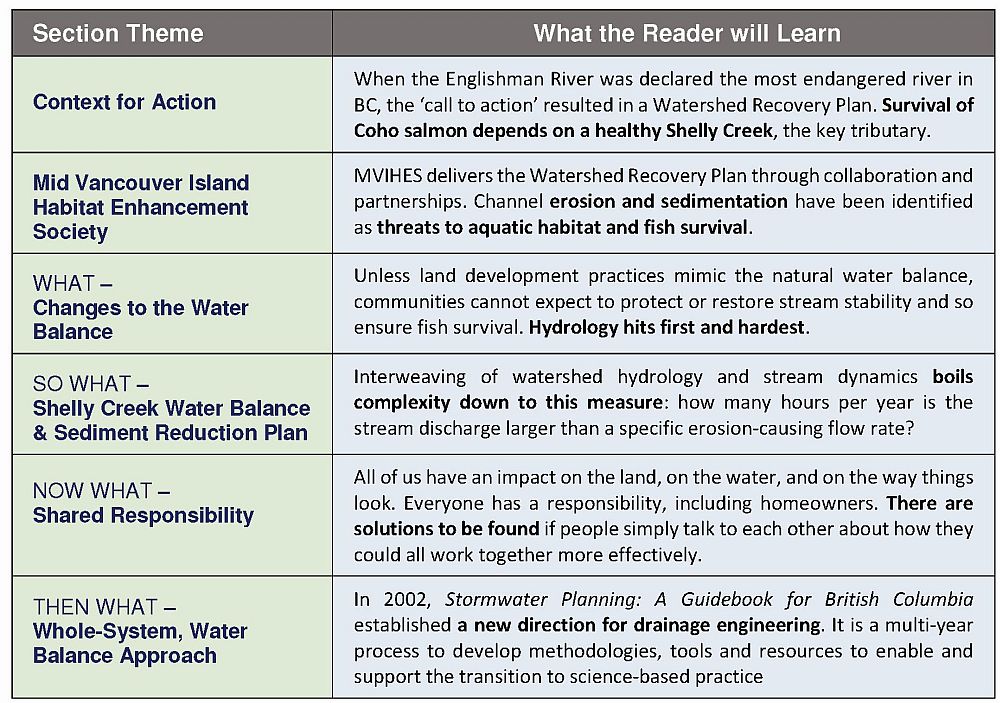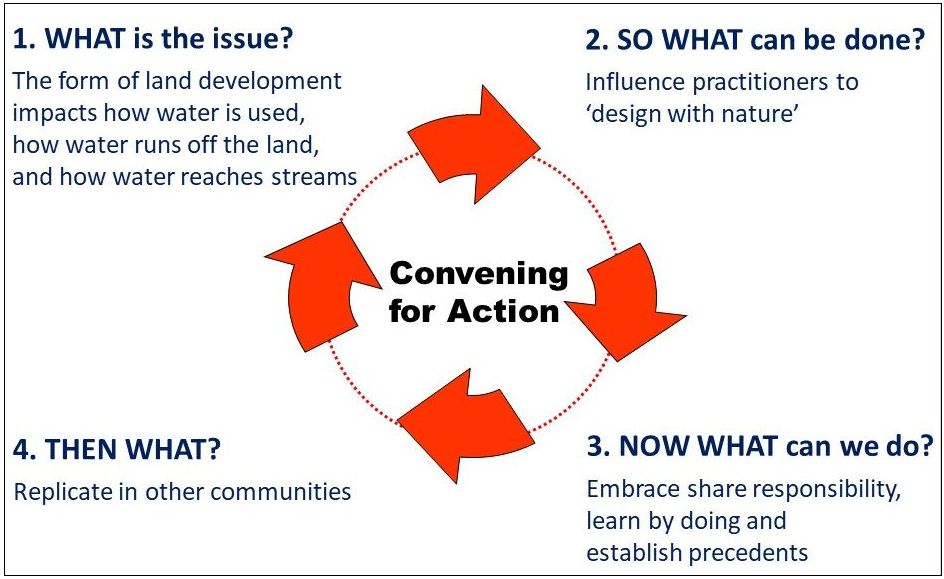RESTORE CREEKSHED HYDROLOGY, PREVENT STREAM EROSION, ENSURE FISH SURVIVAL: “By sharing the story of Shelly Creek, we want readers to recognize that erosion is a common issue impacting salmon and trout habitats in small streams, draining into the Salish Sea,” stated Peter Law, President of the Mid Vancouver Habitat Enhancement Society
Note to Reader:
In 1999 the Englishman River on the east coast of Vancouver Island was declared an endangered river. Extinction of the salmon resource was viewed as a very real possibility. This catalyst for action resulted in two transformational outcomes: implementation of the Englishman River Watershed Recovery Plan (2001); and creation of the Mid Vancouver Island Habitat Enhancement Society (MVIHES).
Fast forward to the present. Shelly Creek, a tributary of the Englishman River that flows through the City of Parksville, is important to salmonids. MVIHES has established a provincial precedent with the Shelly Creek Water Balance & Sediment Reduction Plan; and this will have reverberations as the “Shelly Creek story” becomes well-known.
The Shelly Creek experience foreshadows that an informed stream stewardship sector may prove to be a difference-maker that accelerates implementation of the ‘whole-system, water balance’ approach in British Columbia.
MVIHES – Stewards of the Watershed
Over the past two decades, the evolving role of stream steward groups in British Columbia is exemplified by Englishman River experience. In the 1990s, the ‘Coho salmon crisis’ raised the alarm and galvanized action to tackle the impact of human activities on stream health and fish survival in urbanizing watersheds.
Across Vancouver Island and the Lower Mainland, salmon enhancement stewardship groups formed. Many volunteer groups had their beginnings in small stream salmon enhancement projects.
Look Beyond the Creek Channel
A generation later, most community-based groups still exist. They provide thousands of volunteer hours to restore aquatic habitats. From (salmon egg) incubation boxes to habitat restoration, they partner with fisheries agencies to restore salmonid populations. Now the scope of stewardship sector involvement and influence is expanding beyond the creek channel.
 “Over time, MVIHES has morphed from Stewards of the Plan to Stewards of the Watershed. Beginning in 2011, the MVIHES action plan has concentrated on Shelly Creek. One of five Englishman River tributaries, it is the last fish-bearing creek flowing through the City of Parksville,” states Peter Law, MVIHES President & Director, Partnership for Water Sustainability in BC.
“Over time, MVIHES has morphed from Stewards of the Plan to Stewards of the Watershed. Beginning in 2011, the MVIHES action plan has concentrated on Shelly Creek. One of five Englishman River tributaries, it is the last fish-bearing creek flowing through the City of Parksville,” states Peter Law, MVIHES President & Director, Partnership for Water Sustainability in BC.
Embrace Shared Responsibility
“Through their involvement in MVIHES, community stewardship volunteers are demonstrating what it means to embrace ‘shared responsibility’ and take the initiative to lead by example. A paramount goal is to ‘get it right’ in the stream channel,” reports Peter Law.
“MVIHES secured funding from multiple agencies, in particular the Pacific Salmon Foundation, and including the Partnership for Water Sustainability, and developed the Shelly Creek Water Balance & Sediment Reduction Plan. Two questions defined the conceptual framework for the ‘whole-system, water balance’ approach which underpins the plan:
- What is causing the stream channel to erode and fill with sediment?
- How can community action restore the stream’s health?
“The challenge for MVIHES is to facilitate the community’s journey from awareness to action, expressed as follows: Once a community as a whole acknowledges that there is a problem, and also understands why there is a problem, what will the community do about it?”
To Learn More:
Restore Watershed Hydrology, Prevent Stream Erosion,
Ensure Fish Survival
 “Context is everything!,” wrote Kim Stephens, Partnership Executive Director, in the preface to Shelly Creek is the City of Parksville’s last fish-bearing stream!
“Context is everything!,” wrote Kim Stephens, Partnership Executive Director, in the preface to Shelly Creek is the City of Parksville’s last fish-bearing stream!
The Partnership is one of five organizations that co-funded development of the Shelly Creek Water Balance & Sediment Reduction Plan. The Pacific Salmon Foundation was the primary funder. The other three funders comprised the Mid Vancouver Island Habitat Enhancement Society, City of Parksville and the Regional District of Nanaimo.
Reflections on Moving from Awareness to Action
 “A paramount goal is to ‘get it right’ in the stream channel,” continued Kim Stephens. “A challenge for MVIHES is to move from stop-gap remediation of in-stream problems to long-term restoration of a properly functioning watershed.
“A paramount goal is to ‘get it right’ in the stream channel,” continued Kim Stephens. “A challenge for MVIHES is to move from stop-gap remediation of in-stream problems to long-term restoration of a properly functioning watershed.
“The Shelly Creek experience foreshadows that an informed stream stewardship sector may prove to be a difference-maker that instigates and accelerates implementation of the ‘whole-system, water balance’ approach in the Georgia Basin region and beyond,” concluded Kim Stephens.
“As a co-funder, the Partnership is thrilled to have contributed to the Shelly Creek Plan. Our commitment to the Shelly Creek stream stewardship volunteers is to tell their story far and wide. This Watershed Case Profile is the launch of the storytelling process!
“Kudos to MVIHES. The Shelly Creek Water Balance Analysis has established a provincially significant precedent.”
Table of Contents
The table is a synopsis. It distills the essence of each section into a succinct statement. These create a storyline. Readers are asked to pause and reflect on them before reading the story itself.
To Learn More:
To download the 6th in the Watershed Case Profile Series, click on Shelly Creek is Parksville’s last fish-bearing stream! – Restore Watershed Hydrology, Prevent Stream Erosion, Ensure Fish Survival.




